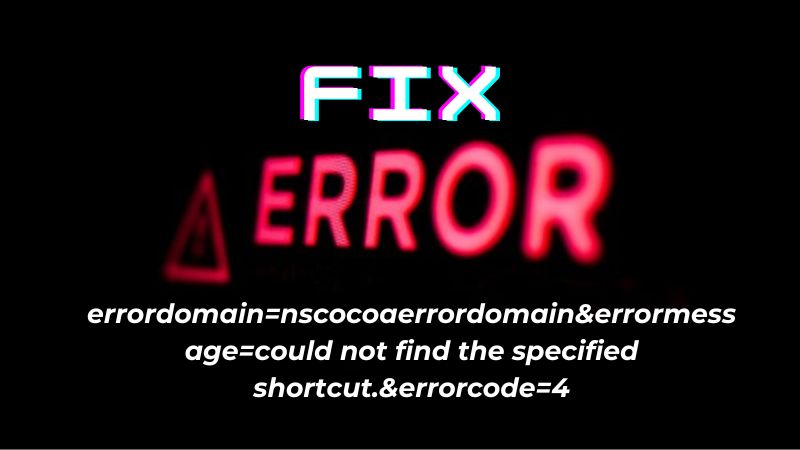When you encounter the error message “ErrorDomain=NSCocoaErrorDomain&ErrorMessage=Could not find the specified shortcut.&ErrorCode=4,” it can be a frustrating experience, especially if you’re not sure what it means or how to resolve it. This comprehensive guide will break down the error message, explore its causes, and provide step-by-step solutions to help you determine the issue and get back to your tasks with minimal disruption.
Deciphering the Error Message
Before diving into the solutions, it’s crucial to understand what the error message entails. The “ErrorDomain=NSCocoaErrorDomain” part indicates that the error originates from the Cocoa framework, a collection of libraries, APIs, and runtime environments that provide the foundation for developing macOS applications. The “ErrorMessage=Could not find the specified shortcut” suggests that the application is attempting to access a shortcut that doesn’t exist or is no longer accessible. Finally, “ErrorCode=4” is a specific identifier that helps pinpoint the exact nature of the problem within the Cocoa framework.
Common Causes of the Error
Several factors can trigger this error message. Here are some of the most common causes:
Missing or Corrupted Files
If the application is trying to access a shortcut that has been deleted, moved, or corrupted, it will not be able to find the required reference, leading to this error.
Application or System Updates
System or application updates can sometimes change file paths or modify shortcuts without user intervention, resulting in broken links and the subsequent error message.
User Permissions
Inadequate user permissions can prevent applications from accessing specific files or directories, causing the system to throw this error.
Software Bugs
Bugs within the application or the operating system can also lead to this error, especially if they interfere with handling or resolving shortcuts.
Troubleshooting and Solutions
Now that we understand what the error message means and its potential causes let’s explore various troubleshooting steps and solutions to resolve the issue.
Verify the Shortcut’s Existence
The first step is to ensure that the shortcut the application tries to access exists. If it’s a file or directory shortcut, verify its location and ensure it hasn’t been moved or deleted.
Check for Application and System Updates
Ensure that both your application and macOS are up to date. Developers often release patches and updates to fix known bugs, including those that can cause such error messages.
Review User Permissions
Ensure the user account running the application has the necessary permissions to access the shortcut. You can check and modify permissions using the Finder ‘Get Info’ option.
Reinstall the Application
If the problem persists, try uninstalling and then reinstalling the application. It can resolve issues caused by corrupted application files or configurations.
Reset System Management Controller (SMC)
If you’re using a Mac with an Intel processor, resetting the SMC can resolve hardware and power management issues, which, although less common, could potentially lead to this error.
Contact Support
If none of the above solutions work, it may be time to contact Apple support or the support team for your specific application. They can provide more in-depth troubleshooting and guidance.
Preventing Future Errors
To minimize the chances of encountering this error in the future, here are some preventative measures:
- Regularly back up your data to recover any lost or corrupted files quickly.
- Keep your applications and operating system current to benefit from the latest bug fixes and improvements.
- Be cautious when modifying system settings or file structures to avoid inadvertently breaking shortcuts or links.
Conclusion
While the error “ErrorDomain=NSCocoaErrorDomain&ErrorMessage=Could not find the specified shortcut.&ErrorCode=4” can be perplexing, understanding its components and potential causes is the first step toward resolution. By systematically troubleshooting and applying the solutions provided, you can overcome this hurdle and ensure a smoother, more reliable experience with your macOS applications.

